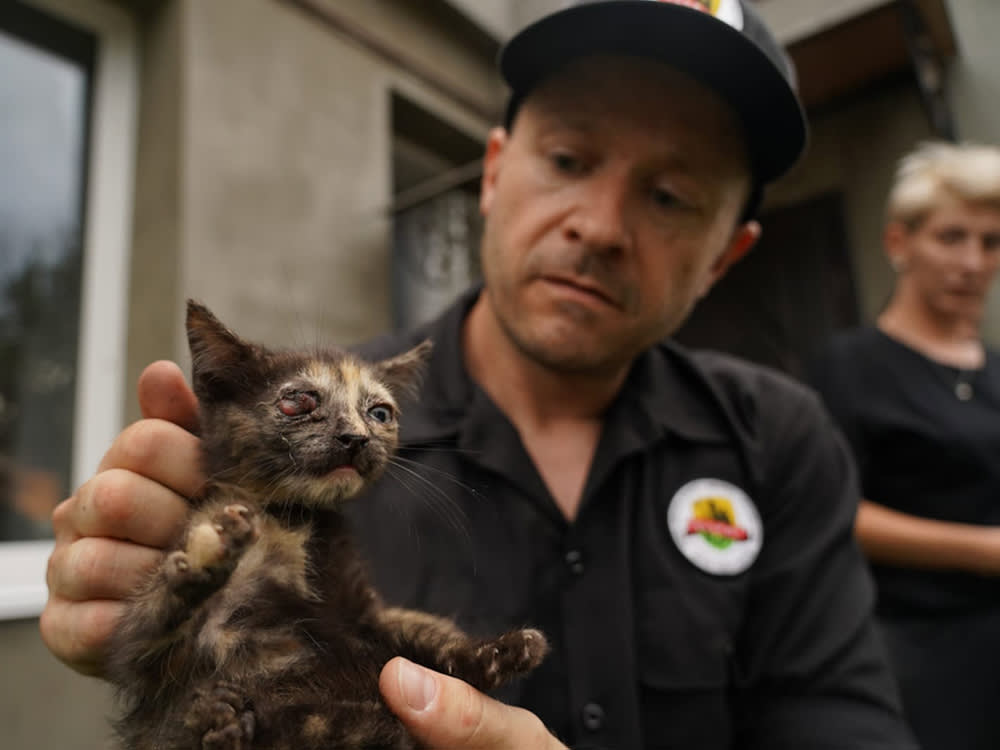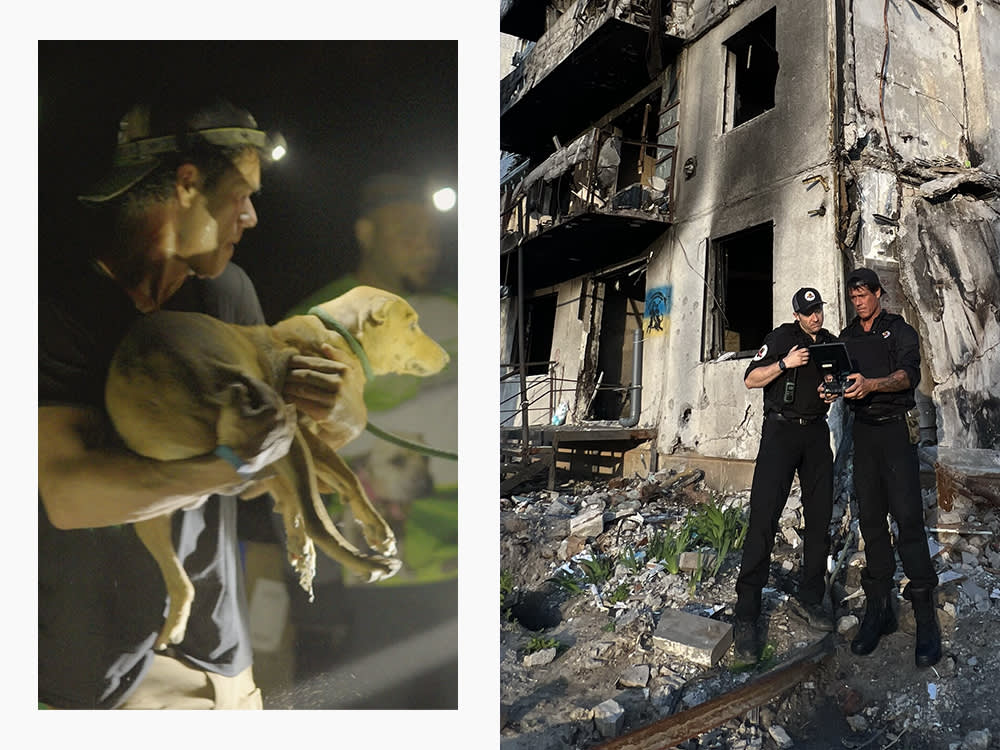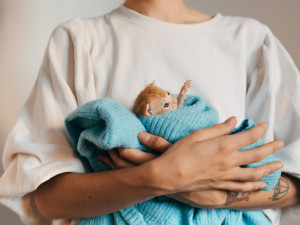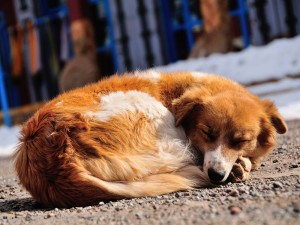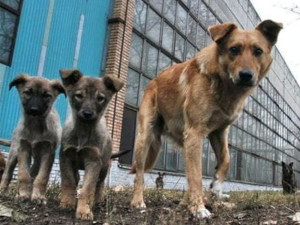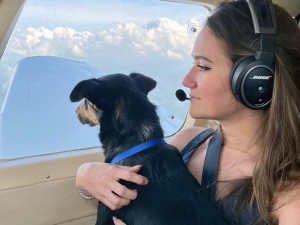We Are Now Living in the Age of Drone Animal Rescue
ASSERT is the first on the ground for emergency aid around the world.
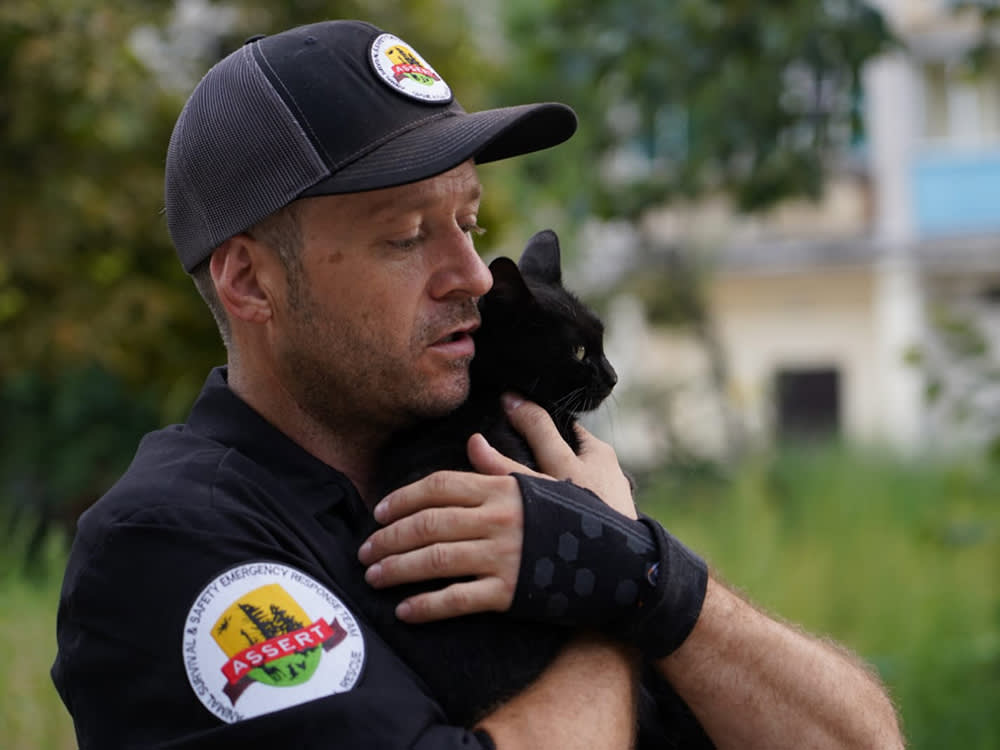
Share Article
You think you love animals? You haven’t met Ryan Okrant, co-founder and executive director of Animal Survival & Safety Emergency Response Team (ASSERTopens in new tab), a drone animal-rescue organization. This dad to three cats (Tuffy McTufferson, Walker Kitten Ranger, and Kentucky Storm) grew up in a cabin in the small mountain town of Boulder Creek, California, where he developed an unconditional adoration for all animals.
When the CZU wildfiresopens in new tab broke out near his hometown in August 2020, Okrant, then living in Florida and working for a cannabis-tools company, grabbed 85 pounds of gear and flew back to Northern California to help.
�“I secured a media pass to enter the closed areas,” he says. “And very quickly, I found that the need to look for, and care for, animals that had been stranded due to the immediate evacuations.” For the next 17 days, he spent every day in the Santa Cruz Mountains, trapping cats, looking for missing dogs, and assisting with livestock. Thanks to the outpouring of support from the local community, he knew he had found his new calling.
In less than two years, Okrant co-founded ASSERT. His work has taken him everywhere from natural disasters in Kentucky to man-made disasters in Ukraine. While he was briefly back in the U.S., Kinship spoke with Okrant about building this humanitarian dream into a 501(c)(3) non-profit organization — and what it’s like rescuing animals in a war-torn country.

You’ve dealt with wildlife and domestic animals. That’s quite an endeavor.
I’ve received training from different wildlife agencies, livestock agencies, and domesticated animal rescues. In order to handle wildlife, I do work under the Santa Cruz Native Animal Rescueopens in new tab permit. I’ve done rescues and transports for them, whether they’re raccoons, skunks, jackrabbits, pygmy owls. I have also received training from one of their best handlers. His name is Kevin Foster — he’s got experience rescuing rattlesnakes and bobcats and animals that are just incredibly challenging for humans to interact with. So I’ve not only got great hands-on training, but also I’ve got an amazing network of allies.
Let’s go back to domestic animals. I would imagine lost dogs are probably going to come to you much easier than cats.
Yeah, I do feel cats are more challenging. I certainly have more experience with cats just because I have had cats as pets my entire life. I’ve gotten comfortable with understanding their energy, when they’re okay with being handled when they’re timid or afraid.
When and how did you start ASSERT?
While I was providing rescue assistance for the CZU complex fires, I was getting massive amounts of animal food donated. People were donating money to allow me to purchase more supplies. I saw a great need for business acumen in the disaster animal-rescue world. With my Business Management Economics degree, I felt that I was a good candidate. I started filing documents with my accountant and [ultimately] filed to be a nonprofit organization.
Do you have a core group of people you work with now?
Yeah, absolutely. When I first began back in August, September of 2020, I had a vision to become the Red Cross of animal welfare. We probably have about 20 active volunteers around the world working on different aspects of ASSERT. It’s allowing us to establish ourselves, not only as a disaster rescue within the continental United States but also now to support all the European nations.
You also recently worked in Kentucky after tornados caused catastrophic damage there.
That was incredibly devastating. In a three-week period, we were able to rescue 41 animals and reunite just over a dozen of them with their owners. I actually rescued my cat Kentucky Storm from that.
What is it like reuniting an animal with their owner?
Generally the person or the family has lost everything in whatever disaster, and the animal has been out, displaced on the streets, terrified for however long a period of time. The moment they connect, it’s just such a satisfying experience — the overall love you see between that owner and that animal. I want to be a part of bringing these lives back together.
When did technology fit into your rescue efforts?
It really was the collaboration in the beginning with [ASSERT cofounder] Douglas Thron. He had worked with a gentleman using infrared hand scopes looking for cats in Northern California after fires. Douglas’s main profession was cinematography, and he was using a drone for a movie that they were filming. He had the idea of trying to find a way to get the infrared scope onto the drone. He and I did a lot of networking online for about two years, prior to meeting for the first time, face-to-face, in Kentucky. Our combined efforts are what led to the 41 animals being rescued in three weeks time.
Let’s talk about Ukraine. How dangerous is it rescuing animals there?
It was certainly the most dangerous mission I’ve been on. The logistics were incredibly complicated; even just physically getting two drones into Ukraine was a challenge. Prior to arriving, I networked extensively through Facebook groups and reached a reliable source that put us in contact with Ukrainian armed-force security guards. They were able to vet our organization and see our desire to assist. They received approval from their commander to essentially escort us throughout Ukraine, [allowing] us to do our animal rescue under their direct protection. That was key to being able to do this, because there’s curfews and checkpoints.
Do you have a relationship with the American government?
Our contacts recommended that we reach out to the U.S. embassy — in order to get their support and verify our identities — to expedite the press passes. They basically told us that they weren’t going to help us whatsoever. In their disclaimer, their email, it said that we should be leaving Ukraine altogether.
What was Ukraine like once you arrived?
Within an hour, we heard our first missile-warning siren. Everybody flees to the subways if they’re out on the streets. We probably heard the missile sirens five day times daily. We got decent rest in the evenings, which helped us make good decisions during the days. Once we got outside of Kyiv — outside of the safety zones — we saw what the tanks and the aerial attacks had done. It’s kind of like a combination of a hurricane and a fire all put together.
How did the animal rescue unfold in all that?
We got the drone out and were able to identify an adult cat on the eighth floor of a building. We were required to wear ballistic helmets and vests the entire time. I set a live trap. About 20 minutes later, she was in the trap. Douglas was able to see one of her kittens, pick it up, and put it in the trap as well. That gave us the suspicion that there could be more kittens. We were not allowed to rescue during curfew, so we strapped infrared trail cams to a chair and left it overnight. In the morning, we found three additional kittens on the footage.
I went ahead and baited the drop trap and sat there in the darkness about 15 meters away, with just a little bit of glowing light on the trap. And after about 15 minutes of complete silence, we saw one kitten pop its head out from around the corner and then slowly a second and third.
When you rescue the cats, where do they go?
Initially, we were using a small foster network in Kiev, where we post photos. We did have positive identification of that mother cat from the sister of the family that owned her. All three members of the family perished in the [bombing]. The father was a very well-respected individual, and there was a large article about his passing. There’s a photo on Instagram that the father posted of his cat, within months of the bombing, calling her his love. That was difficult to learn, but we were going to ensure that she ended up in a loving forever home.
I established a temporary shelter in Kiev, a three-bedroom apartment. I believe we’ve got 57 cats there now, being cared for by our six volunteers. All of the cats, except for the last group, have now been to the vet. I’ll fly from San Francisco to Munich to meet with our European transporter and spend two days preparing our van. We’ll then drive from Munich back to Kiev, where the animal rescue group will help us transport 30 of these [documented] cats out of Ukraine. Our goal is to get them all the way to Boston, where we’ve partnered with an amazing rescue called Sweet Pawsopens in new tab.
Are you rescuing Ukrainian dogs, too?
We wanted to make the largest impact possible, so we kept our focus on cats. Now that we’ve become so established in Kyiv, we’ve got partner rescues reaching out to us. They’re going to make it easier to start supporting cats and dogs. Through our relationship with KARGopens in new tab, we’ve discovered that they’re helping assist a rescue called Serious, which has 5,000 dogs in their care right now. After we return with our van to get 30-ish cats out, we’re going to assess the situation with these 5,000 dogs and develop a plan to help them get out.
Are you still using infrared drones to find more animals there?
Ukraine has changed the ability to fly the drone at a civilian level. They denied all of our flight plan requests during the second mission. In the current state of the war, the drone is not able to be used as a tool at the moment. If that changes, we certainly will use it to locate animals. But we are working on a side [drone] project with the Dominican Republic’s government to return there and help locate dogs stranded out in their rubbish fields and such.
How long will ASSERT stay in Ukraine?
I foresee us staying in Ukraine for the next year, to three to five years — continuing the same process of bringing in groups of cats or dogs, getting them the proper veterinarian care or vaccinations, and getting them out of the country for adoption into forever homes. We are working also on securing sanctuary in Central Europe just outside of Munich.
That would support these efforts and also give us the ability to support other European disasters. And back in the continental United States, we have purchased a 40-foot disaster-response vehicle that we will use to travel around to major disasters in the United States with all of our gear — with the ability to stay on site for extended periods of time.
Have you been able to actually unite Ukrainian owners with their pets?
There was this sweet little gray kitty that seemed very interested in wanting to be rescued. Within about 15 to 20 seconds of approaching me, I scooped it up into my arms and gently got it into a carrier. We took great photos and posted them on all the Ukrainian animal rescue groups. And we were able to locate her owner who lived in the town four to five hours away from where we rescued this cat. She had fled when they were hit but was unable to bring her cat with her.
A volunteer took the cat on a train to be reunited with her owner. Just about two weeks ago, we got some pretty cute photos. While this cat was on the streets, she became pregnant. She just gave birth to four incredibly cute kittens.

Nisha Gopalan
Nisha Gopalan has been a writer/editor for The New York Times, New York magazine, Entertainment Weekly, Variety, The Hollywood Reporter, and NYLON magazines. She currently resides in Los Angeles.
Related articles
![anonymous woman pampering and taking care about a small ginger kitten]()
6 Ways to Help Local Shelters Without Committing to Full-Time Pet Parenthood
Learn how you can be there for animals in need this National Pet Day.
![Stray dog sleeping on the street]()
Four Things to Do If You Want to Adopt a Dog From Another Country
Fall in love abroad? Follow these simple steps to bring your new family member home.
![dr lachlan campbell australian vet in ukraine]()
Australian Vet Dr. Lachlan Campbell on Saving Animals in Ukraine
Bombs, mines, and military checkpoints won’t stop him from evacuating animals from Irpin and running a pop-up vet clinic in Lviv for refugees and their pets.
![A brunette woman holding a black dog with a blue collar, she is wearing headphones and a microphone attachment while seated in a plane with the clouds and sky showing through the window]()
Pilots to the Rescue Has Flown Nearly 400 Animals to Safety This Year
With the help of flight, this nonprofit is saving animals and relocating them to loving homes across the country.
